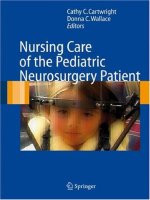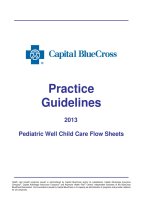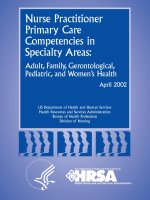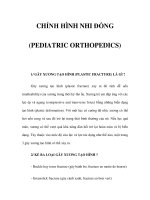pediatric hypoglycemia
Bạn đang xem bản rút gọn của tài liệu. Xem và tải ngay bản đầy đủ của tài liệu tại đây (401.8 KB, 29 trang )
Diagnosis and Management
of Pediatric Hypoglycemia
J. Paul Frindik, MD CDE
Hypoglycemia
•
Two or more sequential blood glucose
values less than 40-45 mg/dl
•
“Hypoglycemia” refers to symptoms or
“low blood sugar” and is not a diagnosis.
Hypoglycemia – Learning
Objectives
•
Symptoms and Definitions
•
Causes of Hypoglycemia
–
Neonatal
•
Transient vs. Persistent
•
Treatment Options
–
Childhood
•
Management
Management Questions
in Acute Hypoglycemia
•
[2 am phone call]: “Doctor, I just checked a
blood sugar on your patient, and it’s 45.
What do you want me to do?”
Management Questions
in Acute Hypoglycemia
•
“Is the patient having a hypoglycemic
episode?”
•
“What are the symptoms of hypoglycemia?”
Symptoms of Hypoglycemia
•
Neonatal
•
Cyanosis, apnea
•
Respiratory distress
•
Poor feeding
•
Hypothermia
•
Seizures
•
Children
•
Inattention, “spells”
•
Lethargy
•
Hunger
•
Behavioral problems
•
Seizures
Symptoms of Hypoglycemia
•
Non-specific and non-diagnostic
•
Correlation between an individual blood
sugar value and
–
Acute clinical symptoms: YES
–
Long term clinical outcome: NO
Pediatrics 105(5):1141-1145; 2000
Definitions of Hypoglycemia
Whipple’s Triad
Diagnosis of acute hypoglycemia requires
1. Clinical symptoms of hypoglycemia plus
2. Simultaneous low plasma glucose plus
3. Clinical signs must resolve when
normoglycemia is established
Ann Surg 101:1299-1310; 1935
Management Questions
in Acute Hypoglycemia
•
“Is the patient having a hypoglycemic episode?”
•
“What are the symptoms of hypoglycemia?”
•
“Do I need to treat ? How? When ?”
Definitions of Hypoglycemia
Suggested Treatment Thresholds
•
Controversies Regarding Definition of
Neonatal Hypoglycemia: Suggested
Operational Thresholds
M. Cornblath et. al., Pediatrics 105(5): 1141-
1145; 2000.
•
“Blood glucose levels at which clinical
interventions should be considered”
Definitions of Hypoglycemia
Suggested Treatment Thresholds
•
Any symptomatic infant with plasma
glucose less than 45 mg/dl
•
Asymptomatic at risk infants with
–
Plasma glucose < 36 mg/dl (feed if possible)
–
Plasma glucose < 20-25 mg/dl (IV glucose)
•
Therapeutic objective is plasma glucose
over 45-60 mg/dl
Pediatrics 105(5):1141-1145; 2000
Management Questions
in Hypoglycemia
•
“Is the patient having a hypoglycemic episode?”
•
“What are the symptoms of hypoglycemia?”
•
“Do I need to treat ? How? When ?”
•
“Does this patient have an underlying medical
condition causing low blood sugars?”
Hypoglycemia – Learning
Objectives
•
Symptoms and Definitions
•
Causes of Hypoglycemia
–
Neonatal
•
Transient vs. Persistent
•
Treatment Options
–
Childhood
Classification of Neonatal
Hypoglycemia
T r a n s i e n t
H y p o g l y c e m i a
P e r s i s t e n t
H y p o g l y c e m i a
N e o n a t a l
H y p o g l y c e m i a
Neonatal Hypoglycemia
Transient
•
Postnatal instability, inadequate fuel
•
2 – 3 per 1000 live births
•
Occurs within first 12 hours after birth
•
Resolves within 3 – 5 days
Transient Neonatal Hypoglycemia
High Risk Groups
•
Premature, SGA, smaller of twins
•
Respiratory distress, sepsis, other stress
•
Large birth weight infants
–
Infant of diabetic mother
hyperinsulinemia from islet cell hyperplasia
Transient Neonatal Hypoglycemia
Treatment
1. Anticipate hypoglycemia in infants at risk
2. Early feeding, if possible
3. Supplemental IV glucose as needed
4. Medication (e.g. steroids) rarely needed
Neonatal Hypoglycemia
Persistent
•
5% of infants with hypoglycemia
•
Persistent (recurrent) hypoglycemia
–
Does not resolve within 5-7 days
•
Hormone deficiencies and excess
•
Metabolic diseases
Persistent Neonatal Hypoglycemia
Etiologies 1
•
Hormone
Deficiencies (15 %)
•
GH Deficiency
•
Cortisol Insufficiency
–
Primary adrenal
–
Secondary pituitary
•
ACTH
•
Physical findings
•
Midline congenital
anomalies
–
Ambiguous genitalia
–
Micropenis
–
Facial anomalies
•
Cleft palate
•
Central incisor
•
Nystagmus
Persistent Neonatal Hypoglycemia
Treatment of Hormone Deficiencies
Diagnosis primary problem
•
Cortisol / ACTH deficiency
Hydrocortisone: ~ 15 mg / M2 / day
•
Divided t.i.d. or q.i.d. P.O. or I.V.
•
GH deficiency
Growth hormone 0.5 mg / day SQ
Persistent Neonatal Hypoglycemia
Etiologies 2
•
Hormone excess (hyperinsulinemia)
–
B cell hyperplasia (neisidioblastosis)
–
B cell adenoma
–
Beckwith-Weideman syndrome
•
Macrosomia, Macroglossia, Microcephaly, ear-lobe
fissures
•
Metabolic diseases (inborn errors of
metabolism)
Persistent Neonatal Hypoglycemia
Suspect Hyperinsulinemia if:
1. Persistent IV glucose requirement of 10-
12 mg/kg/min plus
2. Absence of serum / urine ketones plus
3. Insulin level over 5-10 mcgU/ml with a
simultaneous plasma glucose of less than
40 mg/dl
Persistent Neonatal Hypoglycemia
Treatment of Hyperinsulinemia
1. Diazoxide
10 – 25 mg / kg / day divided t.i.d.
1. Octreotide (Sandostatin)
1 – 20 mcg / kg / day SQ divided t.i.d. or
continuous infusion via insulin pump
1. Glucagon
1 mg / 24 hrs continuous infusion
1. Pancreatectomy
Hypoglycemia – Learning
Objectives
•
Symptoms and Definitions
•
Causes of Hypoglycemia
–
Neonatal
•
Transient vs. Persistent
•
Treatment Options
–
Childhood Hypoglycemia
Childhood Hypoglycemia: Etiologies
•
Hormone
Deficiencies
–
GH Deficiency
–
Cortisol Insufficiency
•
Primary adrenal
•
Secondary pituitary
–
ACTH
•
Insulin Excess
–
Adenoma
–
Exogenous
•
Metabolic Diseases
•
Ingestions
–
Alcohol, Oral
hypoglycemics









